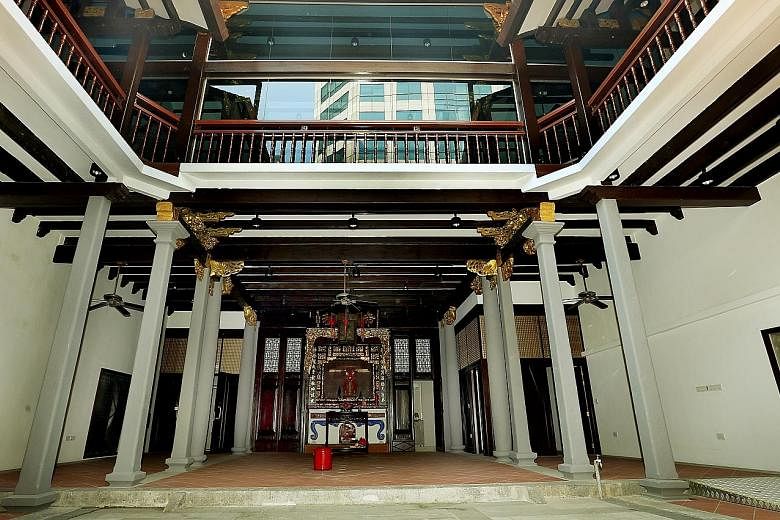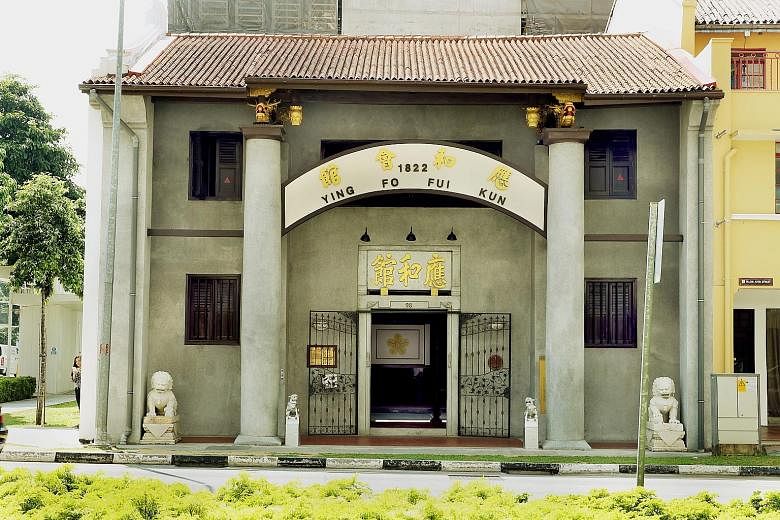Tucked away in the corner of Telok Ayer Street and Cross Street is Ying Fo Fui Kun, Singapore's oldest Hakka clan association, whose building was gazetted as a national monument in 1998.
The building has been shuttered for about two years for renovation works, and will reopen as a public gallery to promote Hakka culture by the end of the year.
Behind its bolted doors in the main hall is an altar dedicated to Guan Sheng Di Jun, the God of War, also known as Guan Yu. He was a Chinese general from the period of the Three Kingdoms, and is revered for his loyalty and his value of brotherhood.
In a deeper sense, he symbolises the hopes of the pioneer members for the Hakka community to be united and its people to take care of one another.
Chinese immigrants flocked to Singapore in the years following Sir Stamford Raffles' founding of this important port in 1819. There were four other main Chinese dialect groups in Singapore: the Hokkiens, Teochews, Cantonese and Hainanese.
In 1822, a group of Hakka clansmen founded Ying Fo Fui Kun under the leadership of Liew Lok Teck. Although the Hakka population was small in comparison with the other dialect groups, it was among the first to establish a clan association.
The association offered support to newly arrived Hakka immigrants, who hailed from five counties in China's Guangdong province: Meixian, Xingning, Wuhua, Pingyuan and Jiaoling.
The association would help them to find accommodation and jobs so they could adapt to their new life in Singapore. It also organised funeral and burial rites for members.

Over time, the association set up a free medical clinic and founded Ying Xin School, which was run in the clan building from 1905 to 1970.
The school made primary education available to the children of the Chinese community by offering low school fees, said Professor Lai Ah Keow, Ying Fo Fui Kun's president.
By 1844, the original single-storey building had become run-down and funds were raised for its reconstruction to today's two-storey structure.
In 1875, an adjacent extension, named Wu Cheng Fu Di, meaning "The Prosperous Land of the Five Cities" in Mandarin, was added. It was built to accommodate the Hakka community's ancestral tablets. But about a century later, in 1980, it was demolished to make way for road widening.
The current building's design is similar to those of other clan-cum-temple buildings found in Guangdong's south-eastern coastal region.
The entrance is set behind two towering columns, which bear an arch inscribed with the name of the association in gold Chinese characters, and the windows are said to have been inspired by the Hakka "tu lou" in China. These are earthen circular dwellings with few windows, set high above the ground to prevent intruders from climbing into the building.
A stairwell in the corner of the building's entrance hall leads up to the second level, where Jia Yuan Ting, or "Hall of Fine Destiny" in Mandarin, is located. Small beams and columns extend from the hall's sloping roof, adorned with golden carvings and paintings of mountains, trees, flowers and people.
Today, Ying Fo Fui Kun has more than 2,000 members.
According to the 2010 census, there are more than 230,000 Hakkas in Singapore and they form the fourth-largest Chinese dialect group.
-
1822
The year a group of Hakka clansmen founded Ying Fo Fui Kun.
-
1998
The year the building of Ying Fo Fui Kun, Singapore's oldest Hakka clan association, was gazetted as a national monument.
Some influential Hakkas here included the late founding prime minister Lee Kuan Yew and Aw Boon Haw, also known as the Tiger Balm King.
The association hands out red packets to elderly members during Chinese New Year, and annually presents study awards to members' children or grandchildren who have performed well academically. It also provides university study loans.
Ying Fo Fui Kun places a strong emphasis on promoting Hakka culture. For example, an interest group for Hakka folk songs meets every Saturday , and the association hopes to introduce a class to teach the Hakka dialect next year.
Prof Lai believes that Ying Fo Fui Kun is still relevant in the present day.
"(The association) still takes care of people, but in a different way. In the past, it was about infrastructure, like hospitals or schools and so on, but now, all this is taken care of by the Government. So now, we tend to culture, mindset and values," he said.
To that end, the proposed gallery, due to open later this year in the building's premises, will acquaint visitors with Hakka culture, which includes Hakka fashion and art.
There will also be various artefacts on display, such as "qiao pis", letters from Hakka immigrants in Singapore to their families in China which record the amount of money remitted home in the 1800s and 1900s.
Prof Lai began collecting Hakka artefacts more than two years ago from the local community as well as Meizhou in Guangdong, the ancestral home of most Hakkas here. Some of the artefacts are also from his personal collection.
"Through the gallery, we hope that young Hakkas will know their roots, and from their roots, their values, as well as the Hakka spirit and way of living. The Hakka spirit is to be hard-working and innovative," said Prof Lai.


